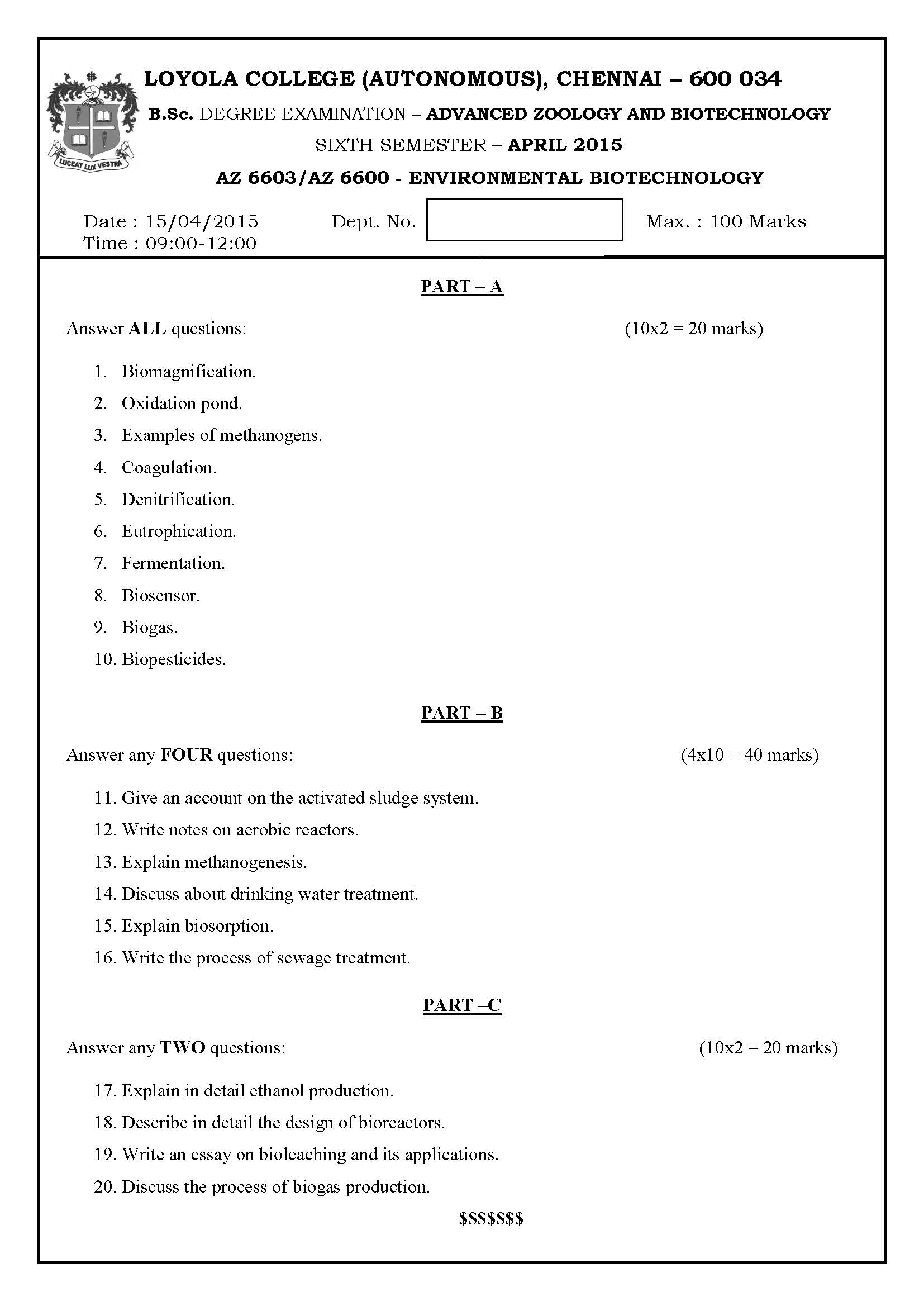LOYOLA COLLEGE (AUTONOMOUS), CHENNAI – 600 034
M.Sc. DEGREE EXAMINATION – BIO TECHNOLOGY
|
SECOND SEMESTER – April 2009
BT 2818 – ENZYMOLOGY & ENZYME TECHNOLOGY
Date & Time: 22/04/2009 / 1:00 – 4:00 Dept. No. Max. : 100 Marks
PART A (20 Marks)
- Choose the best answer: (5 X 1 = 5)
- Energy required by the reactants to undergo the reactions is known as:
(i) Input energy (ii) Energy change (iii) Activation energy (iv) Enthalpy
- Specificity of enzyme mostly depends on the:
(i) Apoenzyme (ii) Coenzyme (iii) Substrate (iv) Reaction
- Coenzyme not related to B complex which is required for glycogen synthesis is:
(i) ATP (ii) CDP (iii) UDP (iv) PAPS
- The enzyme which plays a major role in Myocardial Infarction is:
(i) AST (ii) ALT (iii) LDH (iv) ACP
- The mutant, which plays a major role in the mechanism of α-helix capping is:
(i) A4T (ii) G147A (iii) G189A (iv) K305D
- State True or False: If false give the reason: (5 X 1 = 5)
- Name of the enzyme usually indicates the substrate involved in a particular reaction.
- Synthases and synthatases are different class of enzymes.
- Coenzymes are otherwise called as second substrates.
- Transition state analogs are potential enzyme inhibitors.
- In endergonic reactions, the energy is liberated.
III. Complete the following: (5 X 1 = 5)
- Racemase and epimerase are the examples for the …………… class of enzyme.
- The site at which both the ……………. and……….. are present is called as active site.
- Isoenzymes are distinguishable only by ………………..
- Lysozyme breaks the ……………….. linkages in Glucosaminoglycans.
- Inhibitor responsible for the competitive inhibition closely resembles the …………..
- Answer the following, each within 50 words: (5 X 1 = 5)
- Define – Katal.
- What is Turnover number?
- Define: Enzyme degradation.
- Explain: Enzyme electrode.
- Define – Abzymes.
PART – B
- Answer any five questions, each within 350 words: (5 X 8 = 40)
- Explain in detail about the IUBMB classification of enzymes.
- Discuss on importance and methods for isolation and purification of enzymes.
- Write in detail about the types of reversible inhibition?
- Define multienzyme complex. Explain evolutionary relationship between serine protease.
- Explain the diagnostic importance of SGOT, SGPT and ALP in hepatic diseases?
- Write about enzyme therapy for genetic disorders and cancer.
- Explain in detail about the single point mutagenesis for optimization of industrial enzymes.
- What are proteolytic enzymes? Explain their role in digestive tract.
PART – C
- Answer the following, each answer within 1500 words: (2 X 20 = 40)
- (a) Explain the specificity, salient features and mechanism of action of active sites.
(OR)
(b) Derive Michaelis-Menten equation. Explain the effect of substrate, temperature, pH, and product concentration on the regulation of enzyme activity.
- (a) Explain the Phillip’s mechanism of enzyme action with reference to lysozyme. Give the importance of catalytic residues in serine proteases.
(OR)
(b) Explain the types, advantages and applications of enzyme immobilization with suitable examples.




